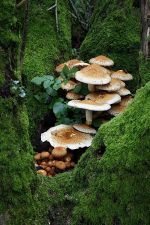Saprotrophic nutrition: Difference between revisions
No edit summary |
No edit summary |
||
| Line 1: | Line 1: | ||
'''Saprotrophic nutrition''' is an example of [[extracellular digestion]] of decayed organic matter by organisms such as fungi and [[soil bacteria]]. Saprotrophic microscopic fungi are often called '''saprobes'''; saprotrophic plants or bacterial flora are called '''saprophytes'''. The process is most often facilitated by active transport of such materials through endocytosis within the internal mycelium and its constituent hyphae. Fungi, bread mould, some protists, and many bacteria are saprophytic in nutrition. | [[File:Saprobes.jpg|150px|thumb|right|Some Shaggy Pholiota growing on trees, these fungi are wood-rotting saprobes]]'''Saprotrophic nutrition''' is an example of [[extracellular digestion]] of decayed organic matter by organisms such as fungi and [[soil bacteria]]. Saprotrophic microscopic fungi are often called '''saprobes'''; saprotrophic plants or bacterial flora are called '''saprophytes'''. The process is most often facilitated by active transport of such materials through endocytosis within the internal mycelium and its constituent hyphae. Fungi, bread mould, some protists, and many bacteria are saprophytic in nutrition. | ||
==Process== | ==Process== | ||
In the presence of decaying organic matter, saprophytes and saprobes release digestive enzymes in their surrounding medium to convert complex organic molecules down to their simpler constituents. This simpler food is then absorbed through the body surface and utilized for various metabolic activities in the saprophyte. | In the presence of decaying organic matter, saprophytes and saprobes release digestive enzymes in their surrounding medium to convert complex organic molecules down to their simpler constituents. This simpler food is then absorbed through the body surface and utilized for various metabolic activities in the saprophyte. An example of this is the breakdown of starch into glucose or sucrose. | ||
*Proteins are broken down into their amino acid components via the breaking of peptide bonds | |||
*Lipids are broken down into fatty acids and glycerol | |||
*Starch is broken down into simpler sugars | |||
===Conditions=== | |||
Revision as of 10:51, 29 April 2019

Saprotrophic nutrition is an example of extracellular digestion of decayed organic matter by organisms such as fungi and soil bacteria. Saprotrophic microscopic fungi are often called saprobes; saprotrophic plants or bacterial flora are called saprophytes. The process is most often facilitated by active transport of such materials through endocytosis within the internal mycelium and its constituent hyphae. Fungi, bread mould, some protists, and many bacteria are saprophytic in nutrition.
Process
In the presence of decaying organic matter, saprophytes and saprobes release digestive enzymes in their surrounding medium to convert complex organic molecules down to their simpler constituents. This simpler food is then absorbed through the body surface and utilized for various metabolic activities in the saprophyte. An example of this is the breakdown of starch into glucose or sucrose.
- Proteins are broken down into their amino acid components via the breaking of peptide bonds
- Lipids are broken down into fatty acids and glycerol
- Starch is broken down into simpler sugars